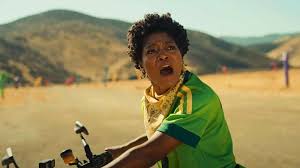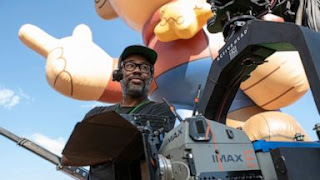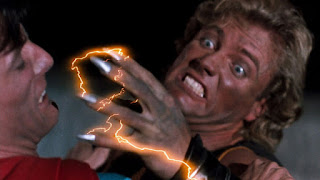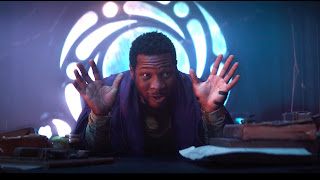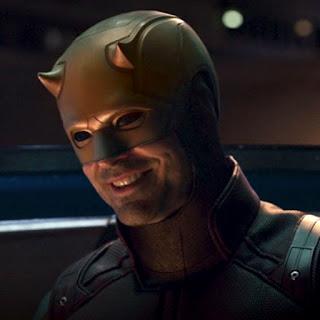While Peele leads the audience (and his characters) to assume that the presence that hovers over the Haywood Hollywood Horses Ranch is a flying saucer that periodically descends from the clouds to bring animals, people, and various random objects aboard, it is eventually revealed to be a living creature that has become territorial and unwelcoming to intruders. Rather than the familiar trope of aliens scooping up specimens to experiment on, the creature of Nope is actually ingesting what it takes into itself. To our surprise, it isn't abducting anyone, it's feeding.
There are no scientists or experts in Nope to give their theories on what the creature is or where it comes from. As with the Graboids of Tremors, there is no origin provided. Is it a part of the natural world that hasn't been discovered until now? Is it an extraterrestrial? Is it some kind of mutated life form? Who knows? What it is and where it comes from is irrelevant to Nope's characters. Siblings Otis Haywood Jr. (Daniel Kaluuya) and Emerald Haywood (Keke Palmer) are initially operating under the belief that they're dealing with alien visitors and that this is just a straight up UFO. So too is former child actor Ricky "Jupe" Park (Steven Yeun) who runs the Western themed park Jupiter's Claim located close to the Haywood Ranch. All these characters have their own ideas on how to cash in on this new visitor.
Otis ("OJ") and Emerald ("Em") see the chance to conclusively document a real UFO as a means to save themselves from the financial ruin that their family business has been facing since the sudden death of their father, Otis Haywood Sr. (Keith David), six months earlier. For his part, Ricky wants to parlay the UFO into a hit attraction (the "Star Lasso Experience") for his theme park but none of them understand what they are even dealing with.
As someone who has spent their life as a horse trainer, once it is eventually determined that the object isn't a ship but a living being, OJ comes to recognize that it has to handled as one would a wild animal, with caution and respect. Ricky's fatal mistake is that he imagines that he has a personal connection with whatever it is. Ricky's back story is that he was a child actor on the set of a '90s sitcom called Gordy's Home, with the titular Gordy being an adorable chimp, until one day helium balloons being used in a scene floated up into the hot studio lights and exploded, which provoked a frightened Gordy into a violent rage. The other actors, including the young girl playing Ricky's sibling, were badly mauled while Ricky himself escaped unscathed. As Gordy was reaching under the table where Ricky was cowering to give him the fist bump that they performed in the show, a police bullet through his brain took out Gordy.
We see this harrowing event play out in flashback from Ricky's terrified perspective as a child while the adult Ricky recounts the event to OJ and Em by describing the SNL sketch that lampooned it, with Ricky glowing with praise for Chris Kattan's portrayal of Gordy. Putting aside the question of whether SNL would actually perform a sketch based on an event involving the maiming of real people (one of whom was a minor), what is compelling about this scene is how Ricky chooses to view the great trauma of his life through a buffer of entertainment. This was a life-altering moment in which he watched his co-workers be brutally attacked and he saw an animal's brains blown out in front of him but rather than cope with the pure horror of that event, he references it not by way of his own first hand experience but through a second hand, satirical depiction.
This says that Ricky has never truly processed what happened to him. Talking about the event from his own perspective would require introspection. It would require sharing something that is unpleasant, uncomfortable and most of all, real. By referencing it by way of a comedy sketch, he is reducing it to a pop culture "moment" rather than an experience that emotionally scarred him.
Ricky dubs the imagined occupants of what he believes to be a ship The Viewers, furthering the idea that Ricky sees everything as entertainment to be safely packaged and consumed. For his Star Lasso Experience presentation he has his kids dressed in alien costumes, he's got a stand of alien themed merchandise to sell, he's wearing a specially designed sequined jacket with a UFO on the back and he has a prepared speech to deliver to the crowd about the life changing experience they're all about to witness but all that's going to happen to any of them is that they're going to become this creature's lunch. The Star Lasso Experience ends with every attendant screaming their way to an agonizing death as they move through a creature's digestional tract. There's not even the relative dignity of being probed on an alien exam table. There's just the very unglamorous reality of being an animal's meal.
The difference between man and animal as illustrated by Peele carries all the way through the film's final chase as the creature zeroes in on OJ and Em. Typically the final chase in a horror movie is purely about survival. Whether it's about staying one step ahead of Jason or Michael Myers or a zombie horde, the remaining characters at that point are always reduced to their own animal states, desperately focusing on staying alive. That is not the case with Nope, however. As desperately as OJ and Em are working to stay ahead of the creature in the final stretch, Em does not let go of her need to get that shot. We've seen countless final chases where it's all about the characters just wanting to get away with their lives and that's it. But this is a big final chase in a horror movie where it's not just about surviving the moment, it's about surviving. Em, who through most of the movie seemed to be the more flaky, less business focused of the two siblings, shows in the end how much she has her eyes on the prize. She knows that it won't enough for her and OJ to just evade this creature and live another day. This about living past that. If they don't get that shot of the creature, if they don't score that winning ticket that will get them out of their economic situation, they've got nothing. The idea of having its characters be in financial as well as physical peril is such a novel wrinkle for a horror film. The creature is only protecting what it sees as its territory. It's pursuit of OJ and Em isn't even personal. It's instinctual. But Em has to think beyond the moment in a way that the beast that's stalking her doesn't.
In the man vs. nature subgenre, whether you're talking about Jaws (1975) or Grizzly (1976) or Razorback (1984), the final battle always comes down to the final survivor having to destroy their attacker. The goal is just to fucking end it. Preferably in spectacular fashion. But OJ and Em's motivation is never to kill the creature. Even though it is technically a threat, they're never worried about it, say, making its way to a populated area. They're not actively looking to stop it. Their entire conflict with it is purely driven by their hopes of scoring a life changing pay day rather than, say, righteous revenge. I think that is an aspect of Nope that is hard to audiences to wrap their heads around. It's just not how the conventions of the genre traditionally play out. Audiences are primed to expect that big payoff where they and the characters revel in the death of the creature. Brody making the shot that explodes the scuba tank in the shark's mouth, Val tricking the last Graboid into burrowing its way out of a cliff side at full speed, sending it plummeting to a splattery death. That is not what Nope is about. It's creature is never demonized in any way. It's never portrayed as purposely malevolent. The deaths it causes are either incidental or caused by people unthinkingly provoking it. To have the big climatic win in Nope be about Em successfully getting that picture rather than OJ and Em high fiving over the creature's shredded carcass is just not the kind of vindication that audiences are conditioned to expect and I think that has led to a sense of dissatisfaction. The fact that Nope doesn't play by the rules is to Peele's credit but it is also why it has not been an across the board crowd pleaser.
Personally, I will say that my experience in watching Nope was one of being objectively impressed with the scope of its ambition and with the technical skill of the filmmaking rather than feeling viscerally drawn in. But as an example of craft, Nope continues to show Peele's considerable development. It offers images that are entirely unique to it along with an assemblage of excellent performances (shout out to the dryly funny Michael Wincott as a jaded, seen it all cinematographer). I don't believe Nope works as well as Get Out or Us but it's still a movie that deserves to be applauded, even as many fans and critics seem more than eager to slam it for not being exactly what they were expecting.
Whether Nope is Peele's best film to date, his first misfire, or somewhere in the middle is ultimately irrelevant. The bottom line is that it's another original work by a writer/director who truly understands and loves the genre and whose work continually provokes discussion. That's something that every horror fan should be saying yes to.











